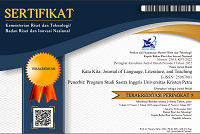The Concept of Happiness in Djarum 76 “Yang Penting Hepii..”
DOI:
https://doi.org/10.9744/katakita.5.2.27-37Abstract
This thesis mainly deals with the process of signification and metaphor in order to reveal the concept of happiness in Djarum 76 video commercial with its tagline “Yang Penting Hepii..”. The focus of the writer’s analysis is the verbal and visual expression in the video commercial as the writer uses Barthes’s process of signification and Lakoff’s and Johnson’s theory of metaphor in analysing the data. Those Barthes’s, Lakoff’s and Johnson’s theories helped the writer analyse the use of verbal and visual expression in the advertisement, then, figured out the concept of happiness in Djarum 76 video commercial. The writer analyses a video commercial of Djarum 76 entitled “Jangkrik”. This research used descriptive qualitative approach to describe the concept of happiness in the video commercial of Djarum 76. From the analysis, the writer found out that the video commercial of Djarum 76 uses process of signification to associate happiness with laughter. In doing so, Djarum 76 used verbal expression to build the patterned plot while the visual expression pictures elements of happiness within each videos to evoke laughter. In conclusion, the use of verbal and visual expression is aimed to make the audiences laugh which then associated with happiness.
References
Chandler, D. (2007). Semiotics The Basics (2nd ed). London: Routledge.
Febrianto, S. (2015). Pengaruh Penggunaan Humor Dalam Iklan Terhadap Brand Recognition (Studi Iklan Televisi Djarum 76 Seri “Jin” pada Mahasiswa Fakultas Ekonomi Universitas Atma Jaya Yogyakarta). Unpublished Thesis of Sarjana S1. Yogyakarta: Universitas Atma Jaya Yogyakarta.
Krippendorff, K. (2004). Content Analysis: an introduction to its methodology 2ed.California: Sage Publication.
Lakoff, G. & Johnson, M. (1980). Metaphors we live by. Chicago : University of
Chicago Press.
Moriarty, S, Mitchell, N & Wells, W. (2009). Advertising principles and practice.
New Jersey: Pearson Prentice Hall.
Percy, L & Elliot, R. (2005). Strategic advertising management. New York: Oxford University Press.
Saurabh, K. (2016). Content Shailee: Semiotics analysis of the iconic ‘Marlboro Man’. Retrieved from https://medium.com/content-shailee/semiotics- analysis-of-the-iconic-marlboro-man-ba933411d465#.8v2vlgbih.
Schreier, M. (2012). Qualitative Content Analysis in Practice. Los
Angeles: SAGE Publications, Ltd.
Storey, J. (2009). Cultural Theory and Popular Culture : An Introduction (5th e d). Harlow,Essex: Pearson Longman.
Wang, D. (1998). The Marlboro Myth. Boulder: University of Colorado.
Downloads
Issue
Section
License
Authors who publish with this journal agree to the following terms:- Authors retain copyright and grant the journal right of first publication with the work simultaneously licensed under a Creative Commons Attribution License that allows others to share the work with an acknowledgement of the work's authorship and initial publication in this journal.
- Authors are able to enter into separate, additional contractual arrangements for the non-exclusive distribution of the journal's published version of the work (e.g., post it to an institutional repository or publish it in a book), with an acknowledgement of its initial publication in this journal.
- Authors are permitted and encouraged to post their work online (e.g., in institutional repositories or on their website) prior to and during the submission process, as it can lead to productive exchanges, as well as earlier and greater citation of published work (See The Effect of Open Access).














